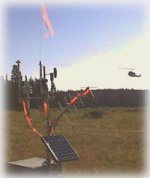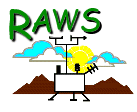|
|
FIRE REMOTE AUTOMATIC WEATHER STATIONS (FRAWS)
 Weather is the most critical factor affecting fire behavior and therefore firefighter safety -- that's what makes FRAWS units so important to fire managers. The enhanced system includes a complete weather station that can be set up in a remote area; it broadcasts weather observations and can be called over the radio by sending out a tone. When parameters that are critical to fireline safety are met, including wind shifts, humidity change, or sudden temperature rise, the station can turn the radio on and broadcast this information. Fire RAWS are intended for use on or near the fireline (or any incident) and are easily and quickly relocated.
Weather is the most critical factor affecting fire behavior and therefore firefighter safety -- that's what makes FRAWS units so important to fire managers. The enhanced system includes a complete weather station that can be set up in a remote area; it broadcasts weather observations and can be called over the radio by sending out a tone. When parameters that are critical to fireline safety are met, including wind shifts, humidity change, or sudden temperature rise, the station can turn the radio on and broadcast this information. Fire RAWS are intended for use on or near the fireline (or any incident) and are easily and quickly relocated.
 The FRAWS NFES #5869 are cached in Boise, ID at the National Interagency Fire Center (NIFC) at the Remote Sensing Fire Weather Support Unit (RSFWSU). Requests can be placed through established ordering channels. The FRAWS records all the data for the duration of an incident. This data also goes out automatically every hour via GOES satellite to ASCADS, which forwards the data to WIMS, the National Weather Service, and the Western Regional Climate Center. The FRAWS NFES #5869 are cached in Boise, ID at the National Interagency Fire Center (NIFC) at the Remote Sensing Fire Weather Support Unit (RSFWSU). Requests can be placed through established ordering channels. The FRAWS records all the data for the duration of an incident. This data also goes out automatically every hour via GOES satellite to ASCADS, which forwards the data to WIMS, the National Weather Service, and the Western Regional Climate Center.
Training sessions for personnel who set up and use the units are offered 3 times per year at Boise, ID to assure qualifications to put the units out in the field and that the equipment will operate properly. Sensors on FRAWS are calibrated at RSFWSU after each use.
The Fire RAWS sensors monitor:
- Wind speed and direction
- Peak winds
- Air temperature
- Fuel temperature
- Fuel moisture
- Relative humidity
- Solar radiation
- Warnings (e.g. low RH, high winds)
Fire managers and FBAs use Fire RAWS weather data to predict fire behavior, prescription times, fire weather forecasting, canyon, and ridgetop winds.
|
For more information about the interagency RAWS program, contact USFS Program Manager Linnea Keating or BLM Remote Sensing Fire Weather Support Unit Manager Herb Arnold.
|
|



 Weather is the most critical factor affecting fire behavior and therefore firefighter safety -- that's what makes FRAWS units so important to fire managers. The enhanced system includes a complete weather station that can be set up in a remote area; it broadcasts weather observations and can be called over the radio by sending out a tone. When parameters that are critical to fireline safety are met, including wind shifts, humidity change, or sudden temperature rise, the station can turn the radio on and broadcast this information. Fire RAWS are intended for use on or near the fireline (or any incident) and are easily and quickly relocated.
Weather is the most critical factor affecting fire behavior and therefore firefighter safety -- that's what makes FRAWS units so important to fire managers. The enhanced system includes a complete weather station that can be set up in a remote area; it broadcasts weather observations and can be called over the radio by sending out a tone. When parameters that are critical to fireline safety are met, including wind shifts, humidity change, or sudden temperature rise, the station can turn the radio on and broadcast this information. Fire RAWS are intended for use on or near the fireline (or any incident) and are easily and quickly relocated.
 The FRAWS NFES #5869 are cached in Boise, ID at the National Interagency Fire Center (NIFC) at the Remote Sensing Fire Weather Support Unit (RSFWSU). Requests can be placed through established ordering channels. The FRAWS records all the data for the duration of an incident. This data also goes out automatically every hour via GOES satellite to ASCADS, which forwards the data to WIMS, the National Weather Service, and the Western Regional Climate Center.
The FRAWS NFES #5869 are cached in Boise, ID at the National Interagency Fire Center (NIFC) at the Remote Sensing Fire Weather Support Unit (RSFWSU). Requests can be placed through established ordering channels. The FRAWS records all the data for the duration of an incident. This data also goes out automatically every hour via GOES satellite to ASCADS, which forwards the data to WIMS, the National Weather Service, and the Western Regional Climate Center.